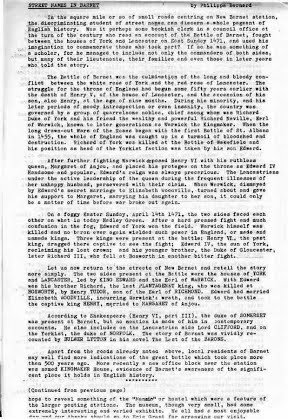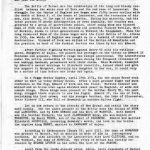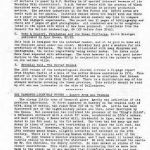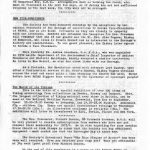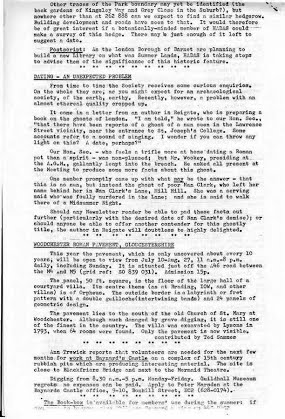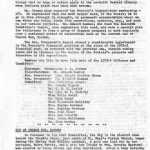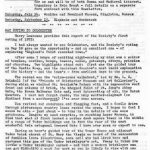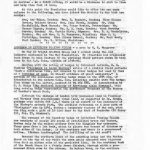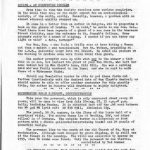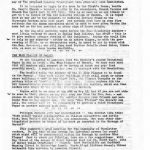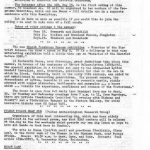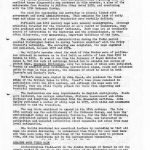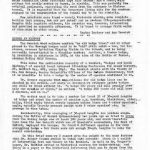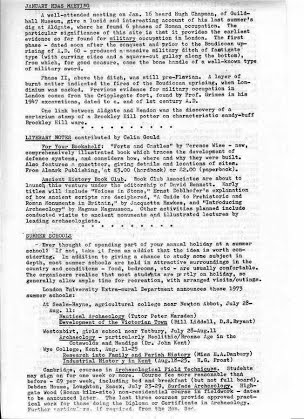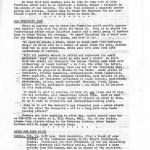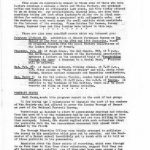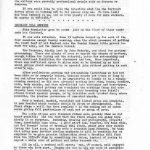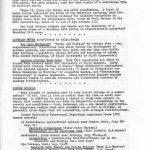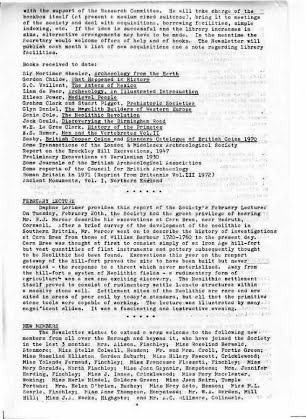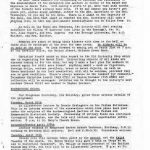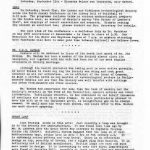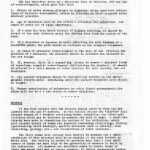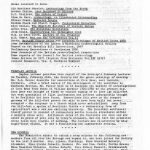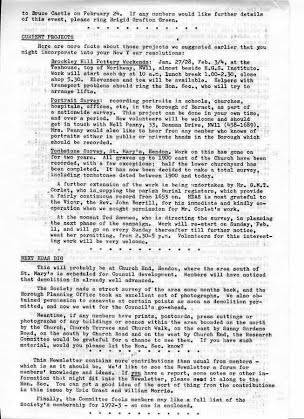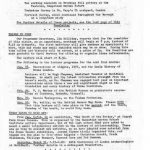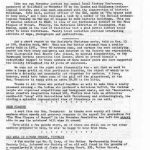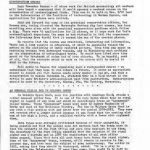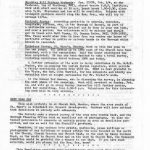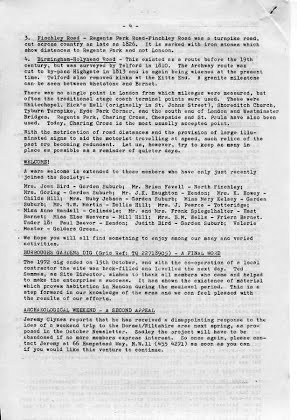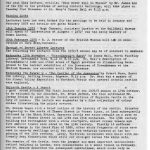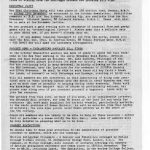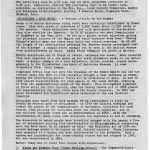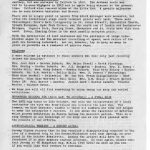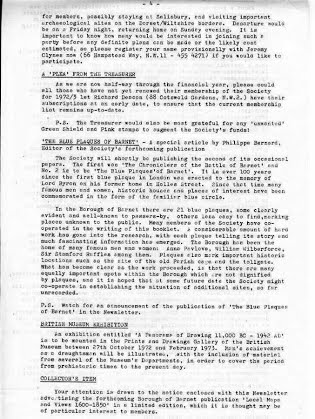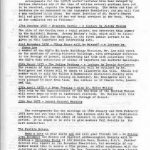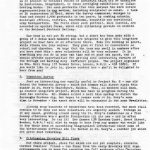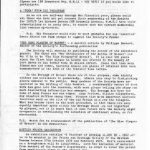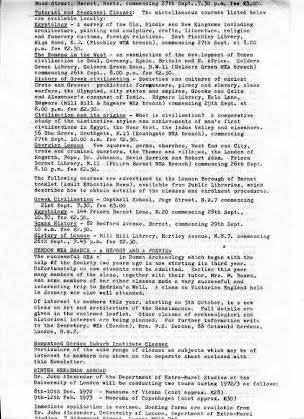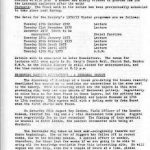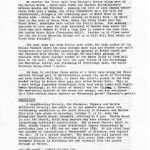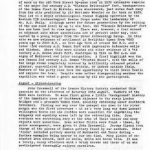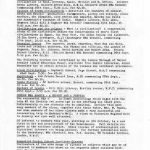Newsletter
Page 1
Church End, Hendon, dig
First news item this month comes from the Society’s current dig at Church End, Hendon. Even after only three weekends’ work the site begins to look interesting.
So far five trenches have been opened. From three of them – each time unfortunately in a disturbed level and therefore unstratified – have come four of the curious flat, grey-green bricks, smooth on one side, which turned up last year at Burroughs Gardens. The Burroughs Gardens bricks were identified by Guildhall Museum as of medieval date, about 13/14th century. Some small body-sherds of black-faced, shell-tempered ware, again similar to that found at Burroughs Gardens, and contemporary with the bricks, have also been found.
A number of clay pipes are among the finds. They seem on the whole rather older than the pipes at Burroughs Gardens, and they too come from disturbed levels and range in date from early 1600s to the end of the last century.
In the two trenches opened closest to Church End itself, the footings are already clearly visible of a house that stood on the site before the shops that were recently demolished (these latter were built before 1895). Three properties are constantly mentioned in 18th century documents as standing on the site. One is the Parish Clerk’s House by the gate of St. Mary’s on the north-west edge of the site. The present Clerk’s House, which has not been demolished, was built in the 1930s, almost certainly on the same spot as its various predecessors. In the 18th century there was behind the Clerk’s House a brewhouse and pigsty.
One of the other two brick-built properties, which are first mentioned in the field book accompanying James Crow’s 1754 map, stood at the corner of Church End and Church Terrace. The other was mid way along between Church Terrace and the Clerk’s House. This second building, from a 1796 description, sounds quite sizeable: “A dwelling house, with a yard and woodhouse with two cottages behind it and a stable in two parts, formerly a brewhouse.” The brewhouse-turned-stable may well be the old brewhouse that stood, 40 years earlier, behind the Clerk’s House. It is the footings of this second house which may now be showing in our trenches.
Last month’s newsletter mentioned the hut obtained by Dorothy Newbury. Now, through yet another member, Mr. E. H. Jack, we have a second. Warm thanks are due not only to them but also to Jeremy Clynes who made all the arrangements for collection with Mr. Jack, and to Raymond Lowe who adapted the shed to fit our needs. Both sheds have been re-floored.
Helpers – both diggers and pot-washers – are vitally needed on the site every Saturday afternoon (except July 14th when there is an outing) and every Sunday morning and afternoon: 2-6 p.m. on Saturdays, 10-1 and 2.30-6.00 on Sundays. Please come if you possibly can and it will help greatly if you let Mrs. Dorothy Newbury know before hand if you are coming.
Outings
Saturday July 14th – Wealden and Downland Museum (Application Form with this newsletter)
Saturday September 15th – Blenheim and Woodstock.
IMPORTANT NOTICE – An extra outing – Last month’s newsletter mentioned the Woodchester Roman pavement (near Stroud, Glos.), which is opened to the public once every 10 years. This being the tenth year, several members have asked if an outing could be arranged to the pavement. A tentative date – Saturday August 11th – is suggested. At least 30 members would be required to come to make the trip economic. Indeed it would be possible to combine Woodchester with a visit to another Roman site much in the news now – Cirencester, where excavation recently has produced altars. Sculpture of the Genii Cucllati and a large early 4th century town house with a bath suite.
Page 2
As well as a visit to a dig, which it is hoped could be arranged, there would be time to see Corinium Museum which has a very fine Roman collection. This would make it a long trip – probably leaving Hendon about 8.30 a.m. and not returning until the same time in the evening.
If you would be interested in coming, therefore, please let Jeremy Clynes know as soon as you read this (or drop him a note). Arrangements such as booking the coach, etc. must be finalised in the next few days, so if Jeremy has not had sufficient response in the next week, the trip will not be arranged.
New Vice-Presidents
The Society has been honoured recently by the acceptance by two eminent residents of the Borough of invitations to become Vice-Presidents of HADAS, and we are doubly fortunate as they are closely in sympathy with our interests. Members who attended the Reception for Mrs. Freedman will remember that one of our guests was the Rt. Rev. Alan Rogers, Bishop of Edmonton, who lives in Friern Barnet and is interested in the Borough’s history and associations. To our great pleasure, the Bishop later agreed to become a Vice-President.
More recently, Mr. Andrew Saunders, M.A., F.S.A, who was appointed in 1972 as the Department of the Environment’s Chief Inspector of Ancient Monuments and Historic Buildings, kindly accepted a similar invitation. He lives in New Barnet, so also has close links with our Borough.
As a footnote, the Newsletter noted with interest last Sunday, that after a Confirmation service at St. Mary’s Hendon, Bishop Rogers strolled across the road and spent quite a time studying the Church End site. Never before have HADAS diggers been watched by the splendour of episcopal purple.
The World of the Vikings
This is the title of a special exhibition of over 500 items of Viking archaeology from collections in Sweden, Norway and Denmark. This, the largest collection of Viking material ever shown in Britain, can be seen at the National Maritime Museum, Greenwich, from May to September. Open: 10.00-18.00 Monday to Saturday, and 14.30-18.00 Sundays. Admission 259 – children 15p. There are special connoisseurs evenings on Thursdays 17.30-22.00 (50p). An illustrated catalogue is available (50p). The exhibition will later be transferred to Kiel, Berlin, Vienna and New York.
Subscription
The Hon. Treasurer, Richard Deacon, will be very pleased to receive subscriptions from members who have not yet renewed their membership for 1973/4. He is also appealing for your surplus Green Shield or Pink Stamps in order that the Society can buy additional equipment – much needed now that the Burroughs dig is under way.
The Blue Plaques of Barnet
The Society’s Occasional Paper, “The Blue Plaques of Barnet” has been very well received. Have you obtained your copy yet? They are obtainable at 34p each (post paid) from Richard Deacon.
Street Names of Barnet
At the end of this newsletter is a paper on the Street Names of Barnet. Philippa Bernard will be glad to have any additional information on the street names of Barnet, whether in connection with the Battle of Barnet or not.
Stone Horse Troughs
Members are asked if they have any knowledge of any stone horse troughs still in existence in the Borough, apart from those at Nether Street (Ballards Lane) and Meadway; one is now in private hands, having stood formerly at Whetstone. Perhaps members may know of others that have been removed and of their subsequent history. Information please to Phillipa Bernard.
Page 3
Roman Corner
Three items dealing with Roman Britain have recently been published:
1. Current Research into Romano-British Coarse pottery, CBA report No. 10
This 166 page report is edited by Alex Deakins, M.A., F.S.A., whose dig at Eccles we visited last summer. It prints 13 papers, plus a summing up by Graham Webster. The papers were given at the CBA conference held at Oxford in March 1972. Twelve contributors, all experts in their own fields have made this a most up to date work dealing with current lines of research. The emphasis is on everyday pottery, where it was produced and its distribution. The following are some of the topics dealt with: pottery from military sites, Dorset black burnished ware, The marketing and distribution of mortaria (a paper by K. F. Hartley is of special interest because of its Brockley Hill connections). R. A. H. Farrar deals with the sources of black burnished ware, and this includes a good section on pottery production methods. The pottery industries of the New Forest and Oxford areas are dealt with in two papers. Imitation Samian wars are dealt with and there is a paper of experimental Roman kilns which members may like to compare with the Highgate experiments. The report has 11 pages of bibliography and there are 7 pages of good photographs. All concerned are to be congratulated on the speed with which it has been processed. (Available from the Council for British Archaeology, £4 (£3 before June 30th).
2. Town and Country, Verulamium and the Roman Chilterns – Keith Branigan published by Spur Books, £2.95.
This book is designed for the informed reader, and it is good to have all the Chiltern sites under one cover. Brockley Hill gets a mention for its production of Mortaria. The book is illustrated with many diagrams and photographs, the latter regrettably being rather muddy. Its index could have been expanded with advantage. The book however is a very good introduction to the subject, especially in conjunction with the author’s report on the Latimer villa.
3. Brockley Hill, The Potter Doinus.
The 1972 volume of the Archaeological Journal carries a 21 page report from Stephen Castle of a kiln of the potter Doinus excavated in 1971. This potter is traceable by his stamped mortaria and he concludes that Doinus was active in the area from 70-110 AD. There is a distribution map of his stamped mortaria covering the Roman province. This article should be read by all who are interested in Sulloniacae.
The Tamworth-Lichfield outing
A report by Ann Trewick.
The sleepy littler town of Tamworth gives hardly any indication of its previous importance. It first appeared in history ads the capital city of Offa, King of Mercia, who ruled from 757 AD to 796 AD. Little has been discovered yet of the eighth century palace and town, later destroyed by the Danes. But excavation has confirmed the presence of the “King’s Ditch”, a defensive earthwork with a ditch 45’ wide, constructed on Offa’s orders, and most exciting, a Saxon water mill, horizontal in type, which has been dated to the 8th century by the C14 method. The town has had many ups and downs in times of unrest, and overlooking it all since the 11th century has been the Castle. Nowadays, within the shell keep can be seen part of a 16th century manor house, slightly converted and extended in the 17th century. There is a fascinating museum within the curtain wall of the keep. It also houses a haunted staircase, and I must admit it turned extremely chilly on descending the staircase! We were shown round the Castle by Mr. Ken Sheridan, the deputy curator. He also showed us slides of the recent excavations. This visit proved so interesting that we were late back to the coach, so it was decided that Lichfield should be our next port of call.
The two towns are close to each other, one dominated by the castle and the other by the church. The present cathedral is the third on the site. Its architecture is mainly Early English with evidence of the transition to Decorated, giving it great grace and beauty. It is dedicated to St. Chad, first Bishop of Mercia, from 669 AD to his death in 672. We were given a very comprehensive talk by the Cathedral Chaplain.
Page 4
Our last visit was to Wall, almost certainly a Roman posting station on Watling Street. There is a very fine bath-house and present excavations hope to reveal something of the “Manzio” or hostel which were a feature of the larger posting stations. The museum, though very small, had some extremely interesting and varied exhibits. We all had a most enjoyable day and our thanks should go to Eric Grant for arranging our visit.
Street Names in Barnet
In the square mile or so of new roads centring on New Barnet station, the discriminating student of street names can discern a whole pageant of English history. Was it perhaps some bookish clerk in a council office at the turn of the century who read an account of the Battle of Barnet, fought between the houses of York and Lancaster on Easter Sunder 1471, and used his imagination to commemorate those who took part? If so he was something of a scholar, for he managed to include not only the commanders of both sides, but many of their lieutenants, their families and even those in later years who told the story.
The Battle of Barnet was the culmination of the long and bloody conflict between the white rose of York and the red rose of Lancaster. The struggle for the throne of England had begun some fifty years earlier with the death of Henry V, of the house of Lancaster, and the accession of his son, also Henry, at the age of nine months. During his minority, and his later periods of moody introspection or even insanity, the country was governed by a group of quarrelsome nobles, chief among whom was Richard, Duke of York and his friend the wealthy and powerful Richard Neville, Earl of Warwick, known to later generations ad Warwick the Kingmaker. When the long drawn out Wars of the Roses began with the first Battle of St. Albans in 1455, the whole of England was caught up in a turmoil of bloodshed and destruction. Richard of York was killed at the Battle of Wakefield and his position as head of the Yorkist faction was taken by his son Edward.
After further fighting, Warwick deposed Henry VI with his ruthless Queen, Margaret of Anjou, and placed his protégé on the throne as Edward IV. Handsome and popular, Edward’s reign was always precarious. The Lancastrians under the active leadership of the queen during the frequent illnesses of her unhappy husband, persevered with their claim. When Warwick, dismayed by Edward’s secret marriage to Elizabeth Woodville, turned about and gave his support to Margaret, marrying his daughter to her son, it could only be a matter of time before war broke out again.
On a foggy Easter Sunday, April 14th 1471, the two sides faced each other on what is today Hadley Green. After a hard pressed fight and much confusion in the fog, Edward of York won the field. Warwick himself was killed and no baron ever again wielded such power in England, or made and unmade kings. Three kings were present at the Battle; Henry VI, the past king, dragged there captive to see the fight; Edward IV, the son of York, reclaiming his lost crown; and his younger brother, the Duke of Gloucester, later Richard III, who fell at Bosworth in another bitter fight.
Let is now return to the streets of New Barnet and retell the story more simply. The two sides present at the Battle were the houses of YORK and LANCASTER, led by KING EDWARD and the Earl of WARWICK. With Edward was his brother Richard, the last PLANTAGANET king, who was killed at BOSWORTH, by Henry TUDOR, son of the Earl of RICHMOND. Edward was married to Elizabeth WOODVILLE, incurring Warwick’s wrath, and took to the battle the captive king HENRY, married to MARGARET of Anjou.
According to Shakespeare (Henry IV part III), the Duke of SOMERSET was present at Barnet, but no mention is made of him in the contemporary accounts. He also includes on the Lancastrian side Lord CLIFFORD, and on the Yorkist, the Duke of NORFOLK. The story of the Battle of Barnet was vividly recounted by BULWER LYTTON in his novel “The last of the Barons”.
Apart from the roads already noted above, local residents of Barnet may well find more indications of the great battle which took place more than 500 years ago. More recently a new office block near the station was named KINGMAKER HOUSE, evidence of Barnet’s awareness of the significant place it holds in English history.
Comments

